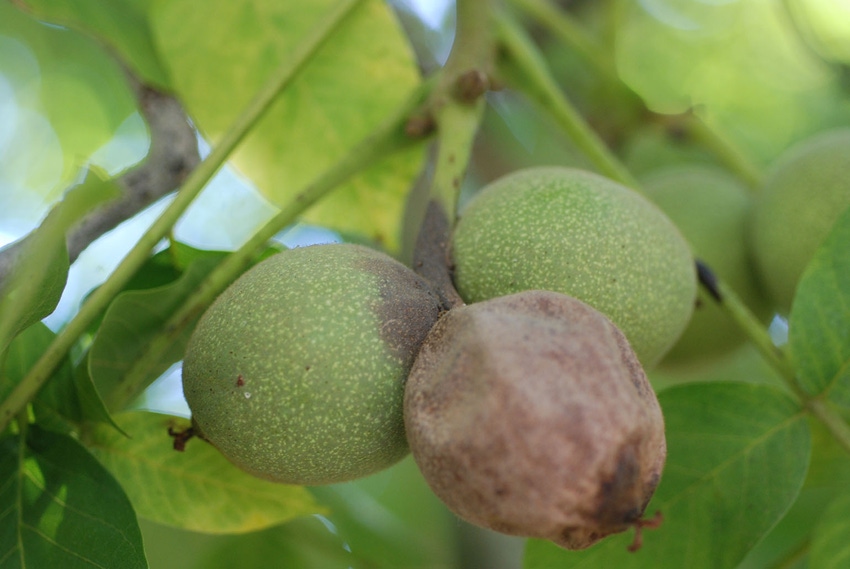
Removing Botryosphaeria-infected wood from walnut trees during the fall months rather than the wintertime can reduce infection rates.
Winter pruning during February results in higher infection rates than an October pruning, according to research conducted by Themis Michailides, University of California (UC) plant pathologist based at the Kearney Agricultural Research and Extension Center in Parlier.
The reason is water and the higher likelihood of rain in February. The hollow pith inside walnut branches acts like a sponge, Michailides explains. The wetness encourages spore germination and pathogen growth when environmental conditions are right.
When a pruning wound is infected, the pathogen establishes a permanent, localized wood infection which cannot be eradicated by fungicide applications. Michailides says wounds in medium-to-large branches made during a February pruning are susceptible to Botryosphaeria (BOT) infection for at least four months after the cut.
The recipe for BOT infection is a combination of inoculum, a quarter inch or more of rain, temperatures above 50 degrees F., and susceptible plant tissues. Infections from this pathogen can be controlled with critically timed cultural practices and fungicide applications.
Untreated, the disease can affect walnut yields by killing buds as trees enter the most productive years.
According to UC Davis Integrated Pest Management Guidelines, Botryosphaeria and Phomopsis make up a disease complex caused by wood-infecting fungi. Spurs, branches, and even fruit can be infected. Symptoms can also include dead spurs, stunted shoots, and bud mortality.
Spores are transported by water and air.
There are 10 species of BOT with at least two Phomopsis which can cause canker and blight in walnut. Four of those species are aggressive. Pruning wounds, fruit and peduncle scars, and leaf scars can become infected. Other diseases and scales can also allow for BOT entry and infection.
Michailides says young walnut trees are generally clean of BOT infection until year five or six. Then most walnut trees can have some degree of infection.
In research trials, Michailides compared infection rates after winter and fall pruning where wounds were inoculated with BOT spores. Winter pruning created infection rates from 78 percent to 99 percent, compared to 28 percent to 75 percent in fall-pruned shoots.
“Growers must do some pruning to direct growth and some cuts can’t be avoided,” Michailides explains.
Looking for signs of infection is important after a wet year, he adds.
There are more BOT infections in northern California walnut growing regions than the drier southern regions. Michailides’ research on the BOT disease complex over the last seven years has shown that properly timed fungicide sprays, good orchard sanitation, and the removal of diseased wood in some cases can result in yield recovery in infected trees and slow disease spread in younger trees.
Fungicide sprays have the most positive effect when applied from the second half of June to early July. Compared with no spray treatment, a single application in low- and high-infected orchards showed a significant decrease in blighted shoots.
Brush removal from infected orchards also reduces the level of inoculum. Pruning or hedging operations should be done first in lightly-infected orchards before moving to more heavily-infected blocks.
The prunings from lightly- and moderately-infected orchards should not be chipped and left, but removed and burned if possible. In young orchards, prunings may be chipped and left. Chipping pruned wood reduces the ability to cause BOT infection by two-thirds, making removal a good option in light- to moderately-infected orchards.
Orchards with a high rate of infection will not benefit from removal as there is a saturation point where additional spore loads reaching the canopies do not add to the infection rate.
About the Author(s)
You May Also Like




